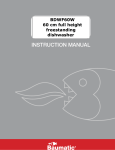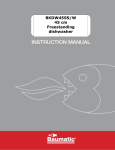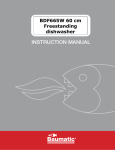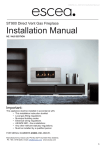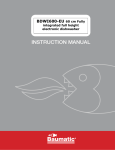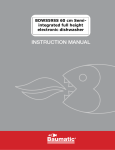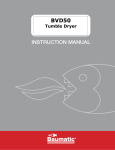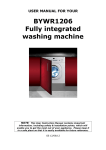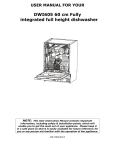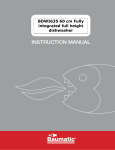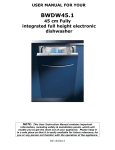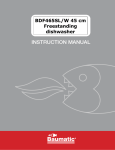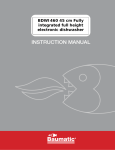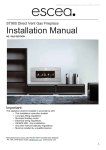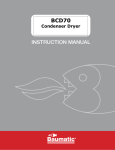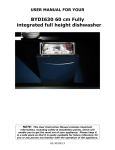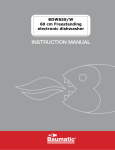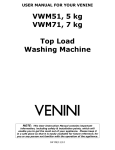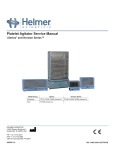Download PDW6-SL/W 60 cm Full Height Freestanding Dishwasher
Transcript
USER MANUAL FOR YOUR PROSSIMO PDW6-SL/W 60 cm Full Height Freestanding Dishwasher NOTE: This User Instruction Manual contains important information, including safety & installation points, which will enable you to get the most out of your appliance. Please keep it in a safe place so that it is easily available for future reference; for you or any person not familiar with the operation of the appliance. JW 07/01/13 Contents Environmental note Important safety information 3 4–6 Specifications Product and aperture dimensions Product specifications Electrical details Description of the appliance Control panel 7 – 10 7 7-8 8 9 10 Using your dishwasher Before first use Filling with rinse aid Setting the rinse aid level Filling with dishwasher detergent Loading the upper basket Adjusting the upper basket Loading the lower basket The cutlery basket Loading dishes and cutlery Program table Setting a wash program Changing a wash program At the end of a wash program Adding an item to the wash cycle Delay start Rinse aid and salt indicator neons 10 - 21 10 11 12 12 - 13 14 14 15 16 16 - 17 18 19 19 20 20 20 20 Saving energy using your dishwasher 21 - 22 Cleaning and maintenance The filter system Cleaning the filters Cleaning the spray arms Cleaning the control panel Cleaning the door Error code failure system General troubleshooting 22 22 22 23 23 24 24 26 Installation Connecting to the mains water supply Connecting to the water outlet Connecting to the power supply Applying the condensation strip Levelling the appliance Before first use 28 - 32 28 29 30 30 - 31 31 31 Contact details 32 - 24 - 23 - 28 - 28 2 ENVIRONMENTAL NOTE Note: Before discarding an old appliance, switch off and disconnect it from the power supply. Cut off and render any plug useless. Cut the cable off directly behind the appliance to prevent misuse. This should be undertaken by a competent person. Disable the door lock to make sure that children cannot get stuck inside the appliance. o The packaging materials that Prossimo uses are environmentally friendly and can be recycled. o Please discard all packaging material with due regard for the environment. 3 IMPORTANT SAFETY INFORMATION Your safety is of the utmost importance to Prossimo. Please make sure that you read this instruction booklet before attempting to install or use the appliance. If you are unsure of any of the information contained in this booklet, please contact the retailer where you purchased your unit. General Safety o Repairs to your appliance must only be carried out by authorised service agents. Any attempt by an inexperienced person to repair the appliance, could result in injury or damage to your dishwasher. o If you notice that the mains cable is damaged. The appliance must not be used. The same applies if you notice that the worktop, control panel or base area is damaged. As this could allow access to the internal components of the machine. o The appliance should be turned off and isolated from the mains supply, before either cleaning or maintenance work is attempted. o The mains cable must not be used to pull the plug out of the electrical socket. o The machine should not be sprayed with water. o The external surface of the appliance may become hot whilst your dishwasher is in use. o It is possible for small animals to chew either mains cables or water hoses, which could cause an electric shock hazard. Installation o The installation instructions contained within this user manual should be followed. o It is obligatory for the completed installation to comply with all relevant building regulations and local water authority requirements. o Before the first use of the appliance, you should follow the steps listed in the “Before first use” section on page 11 and page 31 of this manual. 4 o Care should be taken not to trap the power supply cable underneath the appliance whilst installing it. o No attempt should be made to alter or modify the specifications of this appliance. In daily use o This appliance is only designed to wash normal domestic washloads. If you use your dishwasher in any other way or it is incorrectly used, then the manufacturer accepts no liability for any damage that might be caused and any guarantee will be void. o It is recommended that the appliance is unplugged and the water supply is turned off after the machine is used. o The detergents and rinse aid that you place in this appliance should be suitable for automatic dishwashers. With regards to dosage levels, the detergent manufacturer’s recommendations should be followed. o Sharp knifes or ones with long blades are a potential safety hazard when placed in an upright position in the cutlery basket. We would recommend that these items are placed horizontally in the upper basket. o You should not wash any items that have come into contact with corrosive, acidic or alkaline chemicals, paint, petrol, iron or steel debris. o You should not open the door whilst the appliance is set on a wash program. Depending on which stage that the wash program is at, hot water could escape the machine. o You should not leave the door of the appliance open, unless you are loading or unloading the dishwasher. o You should not stand or sit on the door when it is open. 5 Child Safety o Your dishwasher should only be used by adults. You should not allow children in the area of the machine unsupervised. You should not let them touch the controls or play with the appliance. o It could be possible for a child or pet to gain access to the dishwasher if the door is left open. Therefore please check the inside of the appliance before setting it on a wash cycle. o Any packaging that is removed from the machine should be kept away from children. o All detergents should be kept out of children’s reach in a safe place. o Some water will remain inside the dishwasher when it has completed a wash cycle. This water is not suitable for drinking and may contain residues from the detergents that are used in the appliance. Declaration of conformity o This appliance complies with the standards currently in force. 6 Specifications Product dimensions Height: Width: Depth: 850 - 875 mm 600 mm 600 mm Product specifications o 12 Place settings o 3 functions: Normal Intensive Rapid o 5 temperatures: 40°C, 45°C, 49°C, 55°C, 65°C o o o o o o o o o Noise level: 52 dB Delay start Anti-leak device Anti-flood device Concealed heating element Collapsible plate racks Height adjustable upper basket Adjustable feet Residual drying Energy efficiency details Energy efficiency class: 3 Star 7 Electrical details Rated voltage: 220-240 Vac 50 Hz Supply connection: 10 A For future reference please record the following information which can be found on the rating plate and the date of purchase which can be found on your sales invoice. The rating plate of your dishwasher is located on the right hand side of the drop down door. Model Number ………………………………. Serial Number ………………………………. Date of Purchase ………………………………. 8 Description of the appliance 1) 2) 3) 4) 5) 6) 7) 8) Upper basket Spray arms Lower basket Filters Detergent dispenser Rinse Aid dispenser Cutlery basket Cup holder 9 Control panel 1) 2) 3) 4) 5) 6) 7) ON/OFF button Delay start button Child lock buttons Start/Pause button Rinse aid indicator Drying indicator Program selection buttons 10 Using your dishwasher Before first use Filling with rinse aid The rinse aid is released during the final rinse and it helps to prevent water from forming droplets on your dishes. These droplets will lead to spots and streaks being left on items after the wash program has completed. o Your dishwasher is designed to utilise liquid rinse aid. o The rinse aid dispenser is located inside the drop down door, next to the detergent dispenser. o To access the rinse aid dispenser, you should turn the cap anticlockwise and it will pop out of the hole. Then slowly pour in liquid rinse aid, the rinse aid dispenser will hold approximately 140 ml of rinse aid. o You should continue to fill with rinse aid, until the level indicator turns completely black. o Be careful not to overfill the dispenser, as this could cause oversudsing when a wash program is selected. Wipe away any rinse aid excess or spillages with a damp cloth. o Replace the cap and turn it clockwise until it locks into position. o You should refill the rinse aid dispenser when the rinse aid indicator lights on the control panel (5). o IMPORTANT: If you are using 3 in 1 dishwasher tablets then you should still fill the rinse aid dispenser. 11 Setting the rinse aid level The amount of rinse aid that the dishwasher requires also depends on the hardness of your water. You should experiment with the rinse aid setting, until you find a level that gives the best results. o On the first wash cycle, we would recommend that the rinse aid level is set to number 4. o If you get water spots and poor drying performance, then you should turn the arrow anticlockwise and increase the setting to the next number. o You should continue to adjust the rinse aid level upwards until you get no water spots. o If you get cloudiness or streaking on your dishes, the rinse aid level is set too high and it is causing foaming during the wash cycle. Turn the arrow clockwise and lower the setting to the next number. Filling with dishwasher detergent The detergent dispenser must be refilled at the start of each wash cycle (apart from the Rinse wash program). o Open the lid that closes over the detergent dispenser and place the detergent inside the dispenser. o The section marked 1 in the diagram is for the main wash cycle detergent. Only one detergent tablet should be placed in the dispenser at any one time. If you are using detergent powder or liquid, you should follow the detergent manufacturer’s recommendations. 12 o The section marked 2 in the diagram can have separate detergent placed in it for any wash cycle that has a pre-wash element to it, however this is optional. This must be a liquid or powder detergent, not another detergent tablet. o Shut the detergent dispenser lid so that it clicks shut securely. o At the beginning of a wash cycle the clip will open and the tablet/powder/liquid will enter the dishwasher. Concentrated detergent o The use of the NORMAL program with concentrated detergents reduces pollution and is good for your dishes. o This wash program is specifically suited to the dirt-dissolving properties of the enzymes of concentrated detergent. For this reason, the NORMAL program, in which concentrated detergent is used, can achieve the same results achieved in the INTENSIVE program. Detergent tablets o Different brands of detergent tablets dissolve at different speeds. For this reason, some detergent tablets cannot dissolve and develop their full cleaning power during short programs. o It is recommended that you use longer programs when using detergent tablets to ensure the complete removal of detergent residues. o If you are using 3 in 1 detergent tablets you should check that the water hardness in your supply is compatible with the use of these products, as per the detergent manufacturer’s instructions. o 3 in 1 detergent tablets contain detergent, rinse aid and salt, and as such it may be beneficial to select the lowest setting for water hardness. See ‘setting the rinse aid’ section for details. 13 Loading the upper basket The upper basket is most suited to washing delicate and light dishware, such as glasses, coffee & tea cups, saucers, plates, bowls and shallow pans (that are not heavily soiled). A. B. C. Cups Glasses Saucers o You should position the dishes and cookware in such a way that they are not moved by the spray of water during the wash cycle. o Use the diagram above as a guide to the most appropriate way to load the upper basket. Adjusting the upper basket Your dishwasher has an adjustable upper basket which you can alter to the most suitable position for the items you are going to wash in the upper and lower baskets. o The height of the upper basket can be adjusted by placing the wheels on a different height of the rails. Long items such as cutlery, salad servers and knives should be placed on the shelf so they do not obstruct the rotation of the spray arms. o IMPORTANT: The upper basket must be empty when you are removing it from the guide supports. o NOTE: For easier stacking of pots and pans the cup shelf spikes can be folded down. 14 Loading the lower basket The lower basket is most suited to washing larger and more heavily soiled items, such as saucepans, saucepan lids and serving dishes. You can also load bowls and a variety of plates into the lower basket. G. Dessert dishes H. Dinner plates I. Side plates o Saucepans and serving bowls must always be placed with their bases upwards. o Deep saucepans should be slanted, to allow water to run off. Folding spikes of lower basket o The bottom rack has prongs that can be folded downwards, to allow for easier loading of larger saucepans and serving bowls. 15 The cutlery basket Cutlery should be placed inside of the cutlery basket. The cutlery basket should then be placed in the appropriate position in the lower basket. 1. 2. 3. 4. 5. Teaspoons Dessert spoons Soup spoons Forks Knives o For the best washing performance, cutlery should be placed through the slots in the top of the cutlery basket. IMPORTANT: Do not allow items of cutlery to fall through the bottom of the cutlery basket, as this may cause damage to the spray arm and/or the cutlery. If the bottom of the basket begins to deteriorate and allows items to fall through, you should replace the cutlery basket. Loading dishes and cutlery Household cloths, sponges or any other object that may absorb water SHOULD NOT be washed in a dishwasher. o Remove leftovers and soften the remnants of burnt food in pans, prior to loading dishes in the appliance. o Once the dishwasher has been loaded, check that the spray arms can move freely. If the spray arm comes into contact with any item, then you should rearrange the wash load. o Cups, glasses, pans etc should all be loaded with their bases upwards, so that water does not collect inside of them. o Cutlery and dishes should not cover each other; otherwise you may get poor wash results. o Do not allow glasses to touch inside the dishwasher, otherwise damage may occur. o Small objects can be placed inside of the cutlery basket. 16 The following items are NOT suitable for washing inside a dishwasher:o Cutlery with a handle of mother-of-pearl, wood, horn or china. o Plastic items that are not resistant to heat. o Cutlery that consists of glued parts that are not resistant to heat. o Cutlery items or crockery that are bonded. o Copper or pewter items. o Lead crystal glass. o Wooden platters. o Synthetic fibre items. The following items are not always suitable for washing inside a dishwasher:o Stoneware should only be washed if the manufacturer of the item has marked it as dishwasher safe. o Plastic items (such as lunchboxes) should only be washed if the manufacturer has marked it as dishwasher safe. o Glazed crockery may fade with repeated washing inside of a dishwasher. o Items made of silverware or aluminium can discolour when washed inside a dishwasher. o Any food residue should be removed from silver immediately, as this can also result in discolouration. items o Certain types of glass may become dull or cloudy after a large number of washes. 17 Program table o The ECONOMY program is suitable for cleaning a typical load of dirty dishes and is the most efficient in terms of its combined energy and water consumption. Program Program information Description of cycle Detergent pre/main Normal ** For normally soiled loads, such as pots, plates, glasses and lightly soiled pans. Wash (45°C) Rinse Hot rinse (49°C) Drying Pre-wash (40°C) Wash (55°C) Rinse Hot rinse (65°C) Drying 5 grams (pre-rinse) 25 grams (main wash) Or 3 in 1 5 grams (pre-rinse) 25 grams (main wash) Wash (40°C) Hot rinse (49°C) 15 grams (main wash) Intensive For the heaviest Rapid soiled loads, such as pots, pans, casserole dishes and dishes that have been sitting with dried food on them for awhile. A shorter wash for lightly soiled loads that do not need drying. Program times* Energy (kWh) Water (L) 112 Minutes 0.73 11.8 145 Minutes 1.20 15.5 50 Minutes 0.50 7.5 Or 3 in 1 * The wash program times that are quoted are intended as a guide only. Please note that factors external to the machine, e.g. the temperature of your water supply, your water pressure etc. can affect the time it takes for the wash program to complete. ** NORMAL is the testing program for AS/NZS.2007.1 18 Setting a wash program Make sure that the before first use section has been followed. o Check whether the appliance needs rinse aid adding to it. o Pull out the top and bottom baskets, then load them in accordance with the loading instructions. o Push the top and bottom baskets fully back into position. o Add detergent. o Close the dispenser before starting the dishwasher o Close the door firmly, so that you hear the door lock click shut. o Turn the appliance on by using the ON/OFF button. o IMPORTANT: Wait for 5 seconds before pressing the program selection button, otherwise the appliance may not function correctly. o Press the program selection button to choose an appropriate wash program for the load that you are washing. Where applicable, the relevant program indicator will light to show which program you have selected. o After a few seconds, you will hear the appliance begin to fill with water and the wash program will have started. Changing the wash program IMPORTANT: This should only be attempted when the cycle has only just started, otherwise the detergent tablet may have already released or you could have hot water escaping. o Turn off the appliance using the on/off button and wait for a minute. o Turn the appliance back on using the on/off button. o Select your new wash program. o After about 10 seconds you will hear the appliance begin to fill with water and the wash program will have started. 19 At the end of a wash program o When the wash program is finished a buzzer will sound. o Open the door of the appliance. o Use the ON/OFF button to switch the dishwasher off. o Wait a few minutes before unloading the dishwasher to avoid handling the dishes and utensils while they are still not and more susceptible to breakages. They will also dry better. Adding an item to a wash cycle IMPORTANT: This should only be attempted when the cycle has only just started, otherwise the detergent tablet may have already released or you could have hot water escaping. o Slightly open the door of the appliance and wait for a minute before fully opening the door to avoid scalding by the hot water. o The cycle will pause. The machine will emit a beep and the “Intensive” and “Normal” LED’s will flash. This is an error signal caused by opening the door. o Add the item and then close the door. The cycle will resume after approximately 10 seconds. Delay start o Set your desired wash program as outlined on page 18. o Press the delay start button to delay the start of the wash. o Keep pressing the delay start button until your desired amount of delay is displayed (in hours): Off – 3 hours – 6 hours – 9 hours – Off. o The maximum amount of delay is 9 hours. Rinse aid indicator o The rinse aid indicator on the control panel will let you know when the appliance needs rinse aid adding to it. light indicates that you need to add rinse aid to the o The appliance. You should follow the procedure outlined on pages 11. 20 Saving energy using your dishwasher Loading dishes o Refer to the relevant section of this manual for instructions on placing items in the dishwasher for the most efficient cleaning. o Only run the dishwasher when it is full for optimum energy and water usage. o Check the program table to select the most efficient program according to the size and type of the load. Usage o Clean the filters regularly both to keep the dishwasher clean and to maintain its efficiency. o Always remember to switch the appliance off standby when you have finished using it. Energy is wasted by leaving appliances on standby. o You do not need to rinse dishes off before loading. If you prefer to pre-rinse, use cold water on your dishes before loading them but do not waste water by letting it run continuously. o Use the shorter and lower temperature cycles for everything but the dirtiest dishes. Shorter cycles use less energy and work just as well. Modern detergents also work just as well at lower temperatures. 21 Cleaning and maintenance IMPORTANT: The appliance should be disconnected from your mains supply before commencing any cleaning process. The filter system Your appliance is fitted with three levels of filtering; these are located in the base of the dishwasher for ease of access. 1) Main filter 2) Coarse filter 3) Fine filter Main filter- Food and soil particles are trapped by this filter and pulverised by a special jet on the lower spray arm. This debris is then washed down the drain. Coarse filter- Larger items such as pieces of bone or glass, which could clog the drain, are trapped in this filter. Fine filter- This filter holds soil and food residue in the sump area and prevents it from being redeposited on the dishes during a wash cycle. IMPORTANT: Whilst the filtering system is efficient, your dishwasher is not a waste disposal unit. All items being washed inside of the dishwasher should have food scraps removed from them before being loaded into the appliance. Cleaning the filters For best performance and results, the entire filter assembly should be thoroughly cleaned regularly (ideally after each wash cycle). 1. Turn the coarse filter anti-clockwise and then lift it upwards. The fine filter will come out with the coarse filter. Rinse out these sections under a tap to remove any food debris that remains in it. 22 2. Pull out the main filter and rinse this under the tap to remove any food debris that is trapped in it. 3. Place all position. filters back in their original 4. You must turn the coarse filter clockwise to lock it back into position. IMPORTANT: If a glass gets smashed inside of the appliance, you must check there is no glass in the filter before the machine is used again as this can cause a drainage failure. IMPORTANT: THE DISHWASHER SHOULD NEVER BE SET ON A WASH CYCLE WITHOUT THE FILTERS BEING INSIDE OF THE APPLIANCE. Cleaning the spray arms The spray arms should be cleaned regularly, to prevent hard water deposits from clogging the spray arm jets and bearings. o To remove the top spray arm, unscrew the nut and take out the washer that sits on top of the spray arm and pull to remove. o Gently pull upwards to remove the bottom spray arm. o Wash the spray arm in warm, soapy water and use a soft brush to clean the jets. o Rinse the spray arm thoroughly and then reassemble the spray arm back in its original position. Cleaning the control panel IMPORTANT: Do not use any abrasive cleaner or household polish on either the control panel or operating parts. o Wipe over the control panel using a brand new damp cloth with warm water. 23 Cleaning the door o To clean the edge around the outside of the door, you should use a soft, damp cloth only. o To prevent water from penetrating the door lock or electrical components, DO NOT use a spray cleaner of any kind. o DO NOT use any abrasive cleaner or scouring pads on the inner or outer surfaces, as they may cause damage to them. Error code failure system The following error codes (Flashing display neon’s) can possibly be remedied by the customer and the maintenance steps outlined below should be followed. BEFORE COMPLETING ANY MAINTAINEANCE ON THE APPLIANCE, IT SHOULD BE DISCONNECTED FROM YOUR MAINS POWER SUPPLY. “Delay start” (6 hours) and “Intensive” LED indicators flash o Longer than expected fill time. Check the water pressure of your mains water supply. Clean the mesh filter that sits in the inlet hose. Ensure that the inlet hose is not kinked or crushed. Make sure the water tap that the machine is connected to is turned on fully. Make sure the drain hose has been connected as specified. “Delay start” (3 hours) and “Intensive LED indicators flash. o Longer or extended drain time. The drain pipe may be placed in too high a position or incorrectly. Check the installation instructions and ensure that the installation is correct. Check that the outlet hose is not kinked or crushed. Make sure that the drain hose has not been extended beyond its original length. “Delay start” (3 hours) and “Normal” LED indicators flash. o The machine has sensed water in the base. Check that the outlet hose is not kinked or crushed. Check that there are no blockages in the drain hose or the drainage system that the appliance is connected to. The drain pipe may be placed in too high a position or incorrectly. Check the installation instructions and ensure that the installation is correct. 24 Other error codes: ERROR CODE “Intensive” and “Normal” indicators flash “Normal” and “Rapid” indicators flash “Rapid” and “Delay” (3 hours) indicators flash “Rapid” and “Delay” (6 hours) indicators flash. MEANING Door open POSSIBLE CAUSES The door is open when the dishwasher is operating Temperature sensor Temperature sensor malfunction Water leakage Water leakage occurs Heating element Abnormal heating IMPORTANT: If any of the above fault codes appears then you should check the trouble shooting table on pages 26-27 for possible solutions. If no solution can be found or an error code not listed is displayed then you should disconnect your appliance from the mains supply and contact customer service immediately, quoting the error code. FOR THE ABOVE FAULT CODES, IF THE CODE REAPPEARS AFTER FOLLOWING THE ADVICE AND CLEARING THE FAULT CODE YOU SHOULD TURN OFF THE APPLIANCE. DISCONNECT THE APPLIANCE FROM YOUR MAINS SUPPLY AND THEN ARRANGE FOR A SERVICE TECHNICIAN TO ATTEND THE APPLIANCE BY CONTACTING THE CUSTOMER SERVICE DEPARTMENT. Please note that if a service technician is asked to attend whilst the product is under guarantee and finds that the problem is not the result of an appliance fault, then you may be liable for the cost of the call out charge. The appliance must be accessible for the service technician to perform any necessary repair. If your appliance is installed in such a way that an engineer is concerned that damage will be caused to the appliance or your kitchen, then they will not complete a repair. This includes situations where appliances have been tiled in, sealed in with sealant, have wooden obstructions placed in front of the appliance, like plinths. Or any installation other than the one specified by the manufacturer has been completed. 25 Please refer to the conditions of guarantee that appear on the warranty card that you receive with the appliance. IMPORTANT: The manufacturer operates a policy of continuous improvement and reserves the right to adjust and modify its products without prior notification. General troubleshooting PROBLEM Dishwasher doesn’t run POSSIBLE CAUSES Fuse blown or the circuit breaker has tripped Power supply is not switched on WHAT TO DO Replace the fuse or reset the circuit breaker. Remove any other appliances that are sharing the same circuit with the dishwasher. Make sure that the dishwasher is turned on and that the door is closed securely. Make sure that the power cord is fully plugged into the wall socket. Water pressure is low Drain pump doesn’t stop Overflow Noise Some audible sounds are normal Check that the water supply is connected properly and that the water is turned on. The system is designed to detect an overflow. If it does, then it will run the drain pump continuously when there is power to the appliance. You will get a level of operating noise during a wash cycle, in particular when food is being removed from items and when the detergent dispenser places the tablet into the tub. Utensils are not secure in the baskets or something small has dropped into the basket Ensure that everything is loaded as per The manufacturer’s loading instructions. Motor hums If the dishwasher is not going to be used for a period of time, then you should make sure that the appliance is set on a wash program once a week. Otherwise the seal around the motor may dry out and cause noise. 26 Suds in the tub Improper detergent use Ensure that if you are using 3 in 1 detergent tablets in conjunction with rinse aid that the levels are set correctly. Spilled rinse aid Always wipe up any excess rinse aid or rinse aid spillages immediately. Stained tub interior Dishes are not fully dried Detergent with colourant was used Rinse aid dispenser is empty Use a detergent without colourant. Dishes and pans are not clean Improper program Select a more intense wash program. Improper loading Make sure that the spray arms and the detergent dispenser are not being impeded by large dishes. Spots and filming on glasses and pans Extremely hard water Low inlet temperature Improper loading Improper detergent Improper rinse aid levels Refer to the relevant sections of this booklet, to ensure that the detergent, and rinse aid levels are set correctly. Ensure that the appliance is loaded correctly. Steam A normal phenomenon You may get a small amount of steam coming through the vent by the door latch, during drying and water draining. Black or grey marks on dishes Aluminium utensils have rubbed against dishes Use a mild abrasive cleaner to eliminate the marks. Make sure that the appliance is loaded correctly in future. Water standing in the bottom of the tub This is normal A small amount of clean water in the base of the appliance is not something to be concerned about. Dishwasher leaks The rinse aid dispenser is overfilled or rinse aid has been spilt inside the appliance Take care not to overfill the rinse aid dispenser. Spilt rinse aid could cause oversudsing and lead to overflowing. Wipe away any spills immediately with a damp cloth. Dishwasher isn’t level Make sure that the dishwasher is level. Make sure that the rinse aid dispenser is filled with rinse aid. 27 The Dishwasher is not responding The safety lock is engaged Turn off the safety lock by pressing the safety lock buttons. Turn the appliance off and on again using the power button. Installation IMPORTANT: THIS INSTALLATION MUST BE COMPLETED BY A SUITABLY QUALIFIED PERSON. THE MANUFACTURER ONLY SANCTIONS THE INSTALLATION GIVEN IN THIS INSTRUCTION MANUAL. YOU SHOULD DISPOSE OF ALL PACKAGING IN AN ENVIRONMENTALLY FRIENDLY MANNER. Connecting to the mains water supply IMPORTANT: Do not connect the appliance to your mains water supply using an old or an existing water inlet hose. The inlet hose supplied with the dishwasher is the ONLY one that should be used. DO NOT CONNECT THE WATER INLET HOSE TO A HOT WATER TAP. o Before connection, we would advise running the water to ensure that it is clear and free from impurities as dirty water could block the inlet pipe and damage the machine. o The inlet hose will be located inside the cavity of the dishwasher. o Connect the water inlet hose to a threaded water tap that has a 3/4” thread and to the inlet hose connector on the appliance. o Fully tighten the inlet hose to the water tap and the dishwasher. 28 Connecting to the water outlet o Secure the drain hose, so that it cannot move whilst the dishwasher is in use. o Place the end of the drain hose in your drain pipe and push it a short way down (max120mm) DO NOT SEAL o IMPORTANT: Do not insert the drain hose too deeply into the pipe, as this may cause siphoning. o NEVER EXTEND THE DRAINAGE HOSE FROM ITS ORIGINAL LENGTH. Connecting to the power supply o IMPORTANT: The electrical socket must still be accessible once the appliance is installed. 29 o Consult the rating plate, located on the right hand side of the drop down door BEFORE making the electrical connections. Ensure that the voltage reaching the plug is the same as that on the rating plate. o DO NOT REMOVE THE RATING INFORMATION ON IT IS IMPORTANT. PLATE AS THE o The moulded plug that is supplied with the appliance must be placed into an earthed and insulated socket. o Broken or damaged power leads must only be replaced by a suitably qualified person. A power lead of a similar type must be used in replacement. o Power lead type – H05VV–F 3G 1.5 o IMPORTANT: We do not recommend that this appliance is connected to an extension lead. Applying the condensation strip o The condensation strip must be fitted to the underside of the worktop to protect it against the ingress of moisture. The strip will deflect steam that rises from your appliance, away from the underneath of the worktop. o The condensation strip will be located inside of your dishwasher. o Ensure that the underneath of the worktop is clean before sticking the strip to it. 30 o Separate the backing paper away from the strip. o Stick the condensation strip to the underneath of the worktop. o IMPORTANT: Failure to attach the condensation strip could result in damage to your worktop. Levelling the appliance o IMPORTANT: Your dishwasher must be level for it to operate properly. o Make sure that the dishwasher is supported whilst it is being levelled, otherwise it may tip over. o The feet can be adjusted by hand or by using a spanner. o Use a spirit level to check that the appliance is level o Check that the appliance is level from side to side. o Check that the appliance is level from front to back. Before first use You should check the following before using the appliance for the first time:o o o o o o o That That That That That That That the dishwasher is level and fixed in position. the water tap is fully open. there are no leaks at either end of the drain or inlet hoses. the inlet and outlet hose are fully tightened. the inlet and outlet hoses are not kinked. the power is switched on. the rinse aid dispenser has been filled. 31 Think Appliances Pty Ltd. 416-424 Barry Rd Coolaroo VIC 3048 Sales Telephone 1300 132 824 Service Telephone 1800 444 357 Website www.thinkappliances.com 32

































